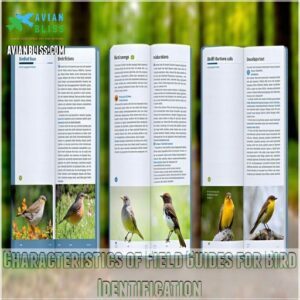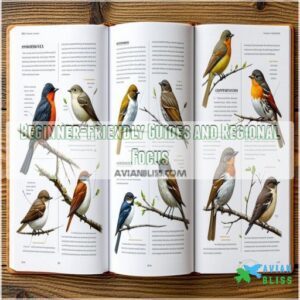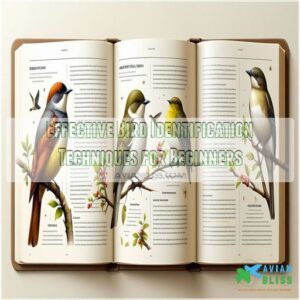This site is supported by our readers. We may earn a commission, at no cost to you, if you purchase through links.
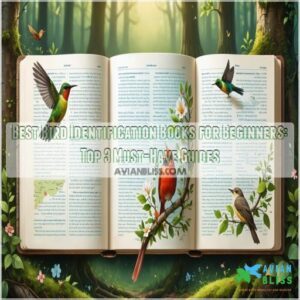 You’ll find three standout bird identification books for beginners that make spotting feathered friends a breeze.
You’ll find three standout bird identification books for beginners that make spotting feathered friends a breeze.
The Peterson Bird Guide North America combines detailed illustrations with practical tools, covering over 500 species with handy range maps.
Sibley’s Guide to Birds Second Edition showcases nearly 7,000 stunning paintings and in-depth behavior insights, for a more thorough approach.
Stokes Eastern Birds Beginners Guide offers color-coded organization and crisp photos, perfect for quick reference in the field, if you’re looking for something more compact.
Like any skilled birder knows, the right guide can transform a casual backyard watch into an exciting adventure of discovery.
Table Of Contents
- Key Takeaways
- Choosing The Right Bird Identification Book
- Characteristics of Field Guides for Bird Identification
- Top 3 Bird Identification Books for Beginners
- Beginner-Friendly Guides and Regional Focus
- Effective Bird Identification Techniques for Beginners
- Frequently Asked Questions (FAQs)
- What is the best book to identify birds?
- What is the best free bird identification app?
- How do I get better at bird ID?
- How do you start a bird life list?
- How do digital bird guides compare to printed books?
- Whats the best time of year to start birdwatching?
- Should I get a waterproof field guide?
- How often do bird identification guides need updating?
- Conclusion
Key Takeaways
- Peterson Bird Guide to North America is your best overall choice, featuring detailed illustrations with arrow markers that will help you quickly identify key features across 500+ species, making it suitable for both beginners and experienced birders.
- You’ll find Sibley’s Guide to Birds, Second Edition, most comprehensive, with 7,000 digitally remastered paintings and extensive behavioral insights, though its wealth of information might feel overwhelming at first.
- For quick field reference, you’ll appreciate Stokes Eastern Birds: A Beginner’s Guide’s color-coded organization and portable size, which focuses on common species with clear photos taking up two-thirds of each page.
- You’ll learn faster by starting with guides that focus on common local species rather than comprehensive nationwide guides, as they will help you build confidence in identifying birds you’re most likely to see in your area.
Choosing The Right Bird Identification Book
Picking the perfect bird book can feel overwhelming, but don’t worry!
Consider your experience level.
Beginner books focus on common birds and have simpler descriptions, while more advanced guides offer greater detail and cover a wider range of species.
Factors to Consider for Beginners
When picking bird identification books for beginners, look for manageable book size, clear image quality, and ease of use.
You can also explore online resources, such as websites offering best bird guide beginners, to supplement your learning.
Stick to options covering common species with simple descriptions.
Budget matters too—choose a price range that feels right.
The best bird books keep it fun, not frustrating, helping you master bird field guides for beginners without feeling overwhelmed.
Importance of Updated Editions and Accurate Illustrations
Updated editions in bird identification books are game-changers.
They guarantee taxonomy changes, species splits, and range updates are current, making identification easier.
Accurate bird illustrations and detailed range maps help you nail tricky IDs without frustration.
Top bird identification guides balance clarity and precision, ensuring you get the most from your birding adventures.
Always prioritize updated, precise guides for success!
Characteristics of Field Guides for Bird Identification
When you’re choosing a field guide for bird identification, it’s essential to understand what makes them effective.
Beginner and standard guides each offer unique features.
Simplified descriptions or detailed coverage to match your needs.
Beginner Guides and Their Limitations
Beginner bird guides keep things simple but have their quirks. Their limited guide scope means they focus on just a handful of species, which can be frustrating as you progress.
While their image quality is usually excellent, descriptions can lack depth.
- Compact size for easy carry
- Simple layouts improve ease of use
- Focused on common species
- Ideal for identifying neighborhood birds
Standard Field Guides and Their Comprehensive Coverage
Standard field guides are must-haves for mastering bird ID. They offer species detail, map accuracy, and illustration quality, making identification straightforward. These books are expertly crafted for accuracy and breadth.
| Feature | Benefit |
|---|---|
| Species Coverage | Extensive range |
| Map Features | Accurate, color-coded |
| Illustration Type | Expertly hand-drawn |
| Expert Reviews | Trusted recommendations |
| Usage | Fantastic for all levels |
They’re an investment every birder appreciates!
Picture Identification Guides and Descriptive Guides
If visuals speak louder to you, picture guides shine by focusing on stunning images, emphasizing ease over thorough descriptions.
For those who prefer a more visual approach, a best bird picture guide can be an excellent resource.
Descriptive guides, however, pair vivid details with text that breathes life into species’ quirks.
Hybrid guides merge both, like best apps for bird identification.
Each approach has its pros and cons, so guide selection depends on your learning style and pace.
Top 3 Bird Identification Books for Beginners
If you’re new to birding, having the right guidebook is key to recognizing species with confidence.
These top three beginner-friendly bird identification books offer clear visuals, detailed descriptions, and practical features to help you get started.
1. Peterson Bird Guide North America

The Peterson Bird Guide North America is a classic that blends stunning illustrations with practical tools for birders.
Its famous arrow system pinpoints key ID features, saving you guesswork in the field.
Covering over 500 species, including Hawaiian birds, it’s packed with range maps, bird topography tips, and detailed sections on shorebirds and raptors.
While some maps are small, the expert guidance it offers still shines.
Perfect for all skill levels, it’s a reliable companion for serious birders and beginners alike.
Best For: Birders of all skill levels, from beginners to seasoned enthusiasts, looking for a comprehensive field guide with detailed illustrations and helpful identification tools.
- Detailed illustrations and arrow system for easy bird identification.
- Comprehensive coverage of North American bird species, including Hawaiian birds.
- Helpful information on bird songs, habitats, and ecological issues.
- Some range maps may be inaccurate or too small.
- Potential for shipping damage.
- Minor taxonomic errors in some pages.
2. Sibley Guide to Birds Second Edition
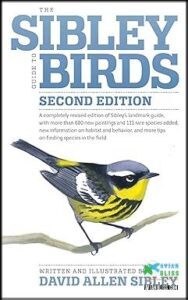
A masterful companion for bird enthusiasts, the Sibley Guide’s second edition boasts nearly 7,000 digitally remastered paintings and expanded information on identification and behavior, providing essential details on bird shapes and sizes.
You’ll appreciate the 15-20% larger illustrations, making subtle details pop off the page.
While some early printings had color inconsistencies, later versions addressed these issues.
The guide’s 624 pages pack in over 600 new paintings, including 115 rare species, and updated range maps.
Despite its thorough nature, beginners might find the wealth of information slightly overwhelming at first.
Best For: Experienced birders and serious enthusiasts seeking a comprehensive and detailed guide.
- Massively expanded information and improved illustrations.
- Nearly 7,000 digitally remastered paintings, including many rare species.
- Updated range maps and taxonomic order.
- Some early printings had color inconsistencies and font issues.
- The sheer volume of information might be overwhelming for beginners.
- Minor labeling errors may still be present in some copies.
3. Stokes Eastern Birds Beginners Guide
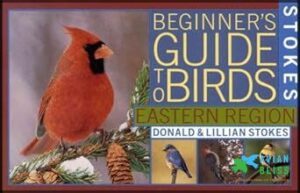
Among beginner-friendly guides, Stokes Eastern Birds stands out for its unique color-coded organization that makes bird identification a breeze.
You’ll find crisp, clear photos taking up two-thirds of each page, paired with concise descriptions covering essential details like voice, habitat, and nesting habits.
Its compact size (4.63 x 0.48 x 7.13 inches) fits perfectly in your pocket or backpack, making it ideal for spontaneous birdwatching adventures.
While it doesn’t cover every species, the guide’s simplified approach and focus on common birds helps you build confidence in your identification skills.
Best For: Beginners, casual bird watchers, children, and anyone looking for a portable and easy-to-use bird identification guide.
- Color-coded organization for quick identification.
- Crisp, clear, and large photos.
- Compact and portable size, perfect for on-the-go use.
- Limited species coverage.
- Concise descriptions may lack detail for advanced birders.
- May not be suitable for identifying all birds in a specific region.
Beginner-Friendly Guides and Regional Focus
You’ll find that regional bird guides can make your first steps into bird watching much easier, as they focus on species you’re likely to spot in your area.
These beginner-friendly books offer clear photos and simple descriptions that help you identify common backyard visitors without getting overwhelmed by too many details.
Simplified Information and Easy-to-Use Features
Modern beginner bird watching books emphasize user-friendly design with visual aids that make learning effortless, much like the basics of birdwatching outlined in bird facts for beginners.
You’ll find clear layouts packed with interactive elements, helping you spot key features without getting overwhelmed.
Popular field guides now use simple language and intuitive organization, making bird identification feel like a natural progression rather than a steep learning curve.
Beginner birding books often include quick-reference tabs and color-coding systems that speed up your identification process.
Focus on Common Species for Initial Bird Identification
Starting with common bird species helps you build confidence in bird identification before tackling rarer finds.
Here’s what focusing on familiar birds can teach you:
- Recognizing distinct features of backyard birds like cardinals and blue jays
- Understanding typical bird habitats in your area
- Spotting key visual identification markers
- Learning common behaviors and feeding patterns
- Mastering beginner bird identification techniques through regular observation
For reliable guidance, beginner birding books often highlight these everyday visitors first.
Regional Guides for Enhanced Learning Experience
Regional field guides narrow your focus to birds you’ll actually see in your area, making beginner bird watching more manageable.
When you’re learning to identify local species, these targeted resources help you avoid the overwhelm of nationwide guides.
For example, if you’re in Maine, a guide specific to Northeast birds will highlight regional variations in appearance and behavior that you might miss in broader guides.
Effective Bird Identification Techniques for Beginners
You’ll discover that identifying birds is like learning a new language, where each species has its own unique set of visual and behavioral clues to help you recognize them.
With the right field guide in hand and a basic understanding of key features like size, shape, and color patterns, you’ll soon be spotting and naming birds with growing confidence.
Using Visual Cues and Descriptions
Most bird identification books teach you to be a visual detective.
When you’re learning bird plumage details, focus on distinct markers like wing bars, eye rings, or tail patterns.
Shape analysis helps too – notice if the bird’s silhouette is round like an American Robin or sleek like a Northern Cardinal.
For tricky species, field guides often highlight size comparison with familiar birds as reference points.
Importance of Practice and Patience in Bird Identification
With patience and practice, you’ll gradually develop an eye for spotting key features that make bird identification second nature.
To supplement your learning, consider investing in beginner bird guide resources, which can be found in stores like beginner bird guides online.
Remember that even experienced birders face challenges when starting out.
Here’s what helps on your learning curve:
- Set aside regular practice time with your bird identification books
- Accept that mistakes happen and learn from each misidentification
- Track your progress in a birding journal to enjoy the journey
Frequently Asked Questions (FAQs)
What is the best book to identify birds?
The National Geographic Backyard Guide to Birds of North America is your best bet for identifying birds. You’ll love its user-friendly format, practical tips, and clear photos of 150 common species.
What is the best free bird identification app?
Bird songs ring through your backyard like a symphony waiting to be decoded.
You’ll find Merlin Bird ID is your best free option.
It identifies birds from photos and sounds with impressive accuracy.
How do I get better at bird ID?
Start by learning common species in your backyard.
You’ll get better at spotting field marks, calls, and behaviors.
Practice daily with a field guide, join local birding groups, and download ID apps.
How do you start a bird life list?
Grab a notebook or birding app to record each species you spot.
Including the date, location, and any distinctive features.
You’ll create a personal record of your growing knowledge and exciting discoveries.
How do digital bird guides compare to printed books?
While printed guides are worth their weight in gold,
you’ll find digital guides offer a universe of instant ID tools, sound recordings, and real-time updates.
Each has unique strengths for your birding journey.
Whats the best time of year to start birdwatching?
Spring is your best bet for birdwatching as migratory birds return north.
You’ll spot colorful breeding plumage and hear mating calls.
But any season offers unique opportunities to observe different species.
Should I get a waterproof field guide?
Like a trusty umbrella in a storm, a waterproof field guide’s essential for year-round birding.
You’ll want one that’s weather-resistant and durable, since you’re likely to encounter rain, dew, or splashes during observations.
How often do bird identification guides need updating?
Bird identification guides typically need updating every 3-5 years.
To reflect changes in species distribution, naming conventions, and new discoveries.
You’ll want the latest edition to stay current with evolving bird populations.
Conclusion
Like a compass guiding you through uncharted territory, the best bird identification books for beginners serve as reliable companions on your birding journey.
Whether you choose Peterson’s detailed illustrations, Sibley’s extensive paintings, or Stokes’ user-friendly approach, you’re equipped to identify the fascinating birds around you.
Start with these trusted guides, practice regularly, and you’ll soon transform from a curious observer into a confident birder who can spot and identify various species with ease.


